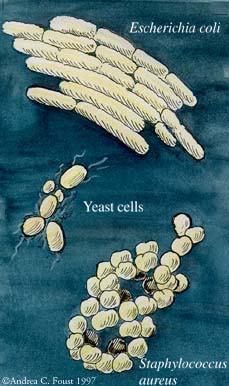MDR pumps don't always work to benefit the
organism. They can bestow deadly power in the form of resistance to
antibiotics to harmful bacteria. While bacterial MDR genes are not
identical to those from mollusks and people, the three-dimensional shape
of all pumps is much the same, and all MDR pumps perform a similar task:
preventing potentially harmful molecules from setting up shop inside their
own quarters, the cell's interior.
Microbiologist Kim Lewis of the University of Maryland at Baltimore,
studies MDR pumps in so-called "gram-negative" bacteria, a group
of microbes that includes the recently notorious E. Coli. One member of
this microbial family, S. aureus , can skillfully evade antibiotic-containing
hospital handsoaps by immediately rejecting their antiseptic weaponry. This
renders the drugs useless, and worse, can lead to menacing and sometimes
deadly infections. "It's a pretty dangerous pest," says Lewis.
Many MDR-like pumps also confer resistance against first-line drugs used
to treat pathogenic yeasts and parasites, says Lewis. Resistance to drugs
called antifungals that are used to treat yeast infections is increasing
rapidly, in particular affecting immune-crippled AIDS patients, who can't
fight back, he says. And the latest victim that may succumb to MDR is saquinavir,
one of a class of anti-AIDS drugs called protease inhibitors, a recent study
suggests. Some bacteria, such as P. aeruginosa, which causes an uncontrolled,
life-threatening infection called sepsis, have a virtual armamentarium of
different MDR pumps. "They extrude practically every [drug] we know
of," says Lewis. |
 |